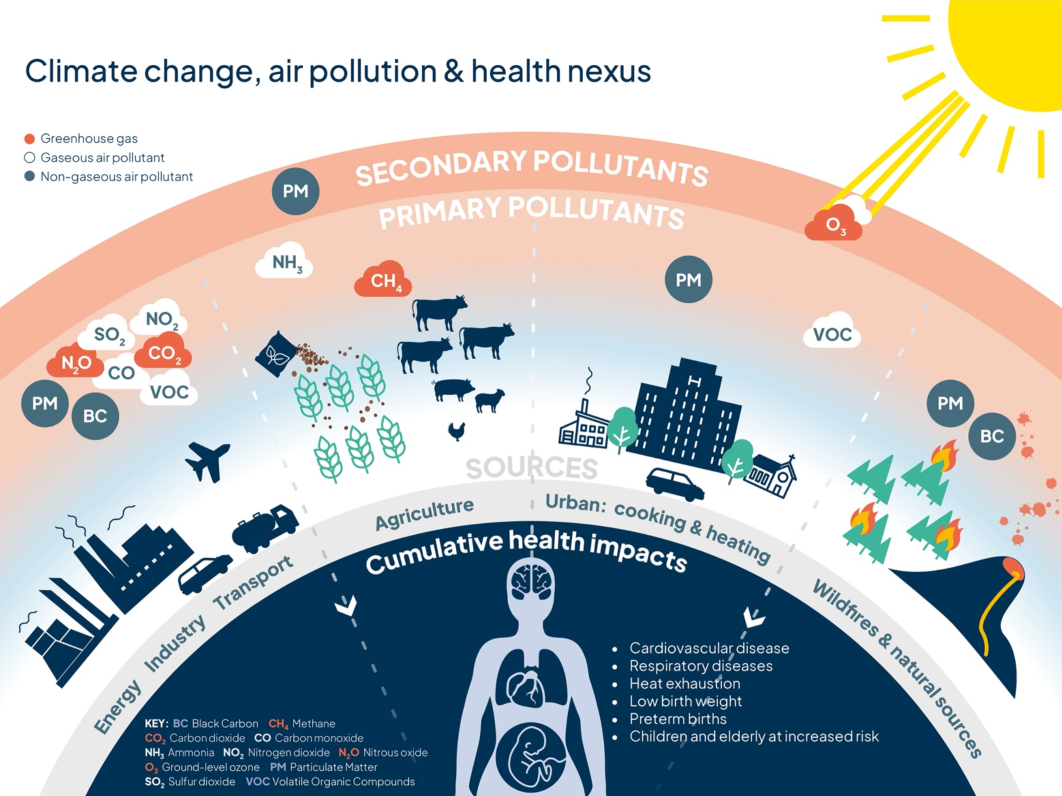
You are here
A critical moment: air pollution, climate and health
Starting today, delegates from around the world will gather in Dubai for the 2023 United Nations Climate Change Conference, or COP28. For the first time, a Day of Health will be observed. While the health impacts of climate change are varied, impacts from exposure to air pollution are well known. In recent years, massive wildfires, extreme heatwaves, and more frequent dust storms have proven to be devastating to air quality in regions around the globe. Such events have intensified air pollution exposures for millions of residents, posing significant risks to public health and well-being. The complex interactions between climate change and air quality mean that coordinated action can lead to better public health and improved societal outcomes. They have also underscored just how much air quality, climate, and health are connected. Many sources of air pollutants co-emit greenhouse gases (Figure 1), and early evidence has shown that the joint effects of heat and poor air quality together may be worse than effects from either exposure alone.
Exposure to air pollution is a leading risk factor for both children’s health and chronic, non-communicable diseases (NCDs) in adults. Nearly 80% of the total air pollution disease burden is linked to NCDs such as ischemic heart disease, chronic respiratory diseases, and diabetes. Exposure to air pollution not only causes early death, but can also lead to poor quality of life, high healthcare costs, and loss of productivity, compounding health impacts with large-scale economic and societal impacts. Read along to learn the various ways in which air pollution and climate change can influence public health.
Figure 1: The connections among climate change, air pollution, and health. (Source: Centre for Climate Engagement, University of Cambridge, UK)
Wildfires and Air Pollution: In 2023, large parts of Canada and the United States experienced very poor air quality, in some cases for the first time in decades. Wildfires and resulting pollutant exposures, especially fine particulate matter (PM2.5,), are likely to increase in both intensity and frequency in regions around the world. This has important implications for both air quality management planning and public health. In the US, several studies have reported increases in emergency department visits, especially for respiratory ailments, as well as higher hospitalization rates during wildfire events. Similarly, in Australia, the 2019–2020 bushfires led to short-term but extreme PM2.5 exposure for over 400,000 people and resulted in hundreds of deaths. And the impacts aren’t on health alone. One study estimated that between 2007 and 2019, wildfire-linked pollution reduced earnings by $125 billion annually across the US. Exposures during such high-pollution events can also increase vulnerability to infectious diseases and other health issues.
Figure 2: Examples of air pollution-extreme weather events with large public health impacts.
The Climate Penalty: Heatwaves, Ozone and Health. It is well understood that higher temperatures during heatwaves can result in higher ozone episodes, especially in densely populated urban areas, and can also trigger the formation of fine particles in the air. Ground-level (or tropospheric) ozone is a highly reactive pollutant and a short-lived climate pollutant. Exposure to ozone has adverse effects, including risk for acute respiratory illnesses as well as chronic respiratory diseases such as chronic obstructive pulmonary disorder (COPD). High ozone levels can also lead to reductions in crop productivity. There is growing evidence for the so-called climate penalty ― that is, warming temperatures resulting in higher levels of air pollution, in turn impacting health, hospital visits, and premature mortality.
In 2022, ozone exceedances were observed during a heatwave across Europe. In China, co-occurrence of heatwaves and ozone exceedances has been reported between 2013 and 2020.
Thus, an important question from a scientific and policy context is, how do we best plan for the impacts of climate change on air quality?
Health Risks to Millions from Dust Storms: Earlier this year, central Asian countries, including Tajikistan, and West African countries, including Ghana, experienced severe air quality episodes due to intense dust storms. Because of climate change, dust storms in the future are likely to intensify, posing severe health risks for millions. In 2021, Uzbekistan experienced the worst dust storm since 1871, triggered by a heatwave earlier in the year, exposing thousands to PM2.5 levels close to 300 µg/m3 for nearly 10 days.
The 2021 WHO Air Quality Guidelines provide guidance while acknowledging the severity desert dust and sandstorms pose as a source of air pollution. Exposure to dust has been linked to a higher risk of lung inflammation and allergic lung diseases like asthma in adults and children.
Integrated Action Brings Public Health Benefits. Anthropogenic, combustion-related sources account for nearly 40% of the total PM2.5 pollution globally, while also contributing substantially to greenhouse gas emissions. In addition, agriculture is both a significant source of methane, a potent greenhouse gas, as well as air pollution, including particulate matter and nitrogen. 4 in 10 global chronic obstructive pulmonary disease (COPD) deaths are linked to exposure to air pollution.
2 in 10 global diabetes deaths are linked to exposure to air pollution. In many low- and middle-income countries (LMICs), lack of access to clean energy results in use of solid fuels for cooking, with a large burden of disease stemming from exposure to household air pollution. While there are no silver bullet solutions, sector-specific interventions that improve air quality can also simultaneously lead to reductions in greenhouse gas emissions. Also, while these problems are global, people living in LMICs or from marginalized communities are very often disproportionately impacted. A recent global assessment on fires reported an increase in exposure to fire-related pollutants, with the greatest impacts coming in Africa and Southeast Asia.
The Good News: There’s clear evidence that improved air quality can yield public health dividends. In California, for example, researchers observed improvements in children’s lung health as the air quality improved. Similarly, in China, a stringent air pollution control program with a focus on energy generation, industry, household fuel use, and transportation led to marked improvements in air quality. In 2022, Beijing registered PM2.5 levels below the WHO Interim Target 1 for the first time. Several countries, including Bangladesh and Colombia, have included clean air action within their Nationally Determined Contributions, the commitments made by countries under the Paris Climate Agreement. Some, such as Ghana, have also prioritized actions to reduce air pollution or greenhouse gases based on the potential public health benefits.
This year’s Health Day at the COP28 conference offers an important opportunity to understand and jointly address the health impacts of air pollution and climate-related extreme weather events. As countries, regions, and cities grapple with air pollution’s growing health and social burdens, it is vital that we examine more closely climate change’s role in extending that burden. Many solutions already exist, and targeted action can help improve public health while also addressing global economic, educational, and social disparities.

